Anatomy 42 | Pharynx & Larynx
1/29
There's no tags or description
Looks like no tags are added yet.
Name | Mastery | Learn | Test | Matching | Spaced |
|---|
No study sessions yet.
30 Terms
What is the path of air through the upper airway?
Air enters through the nasal or oral cavity, passes the nasopharynx or oropharynx, then moves to the laryngopharynx and into the larynx.
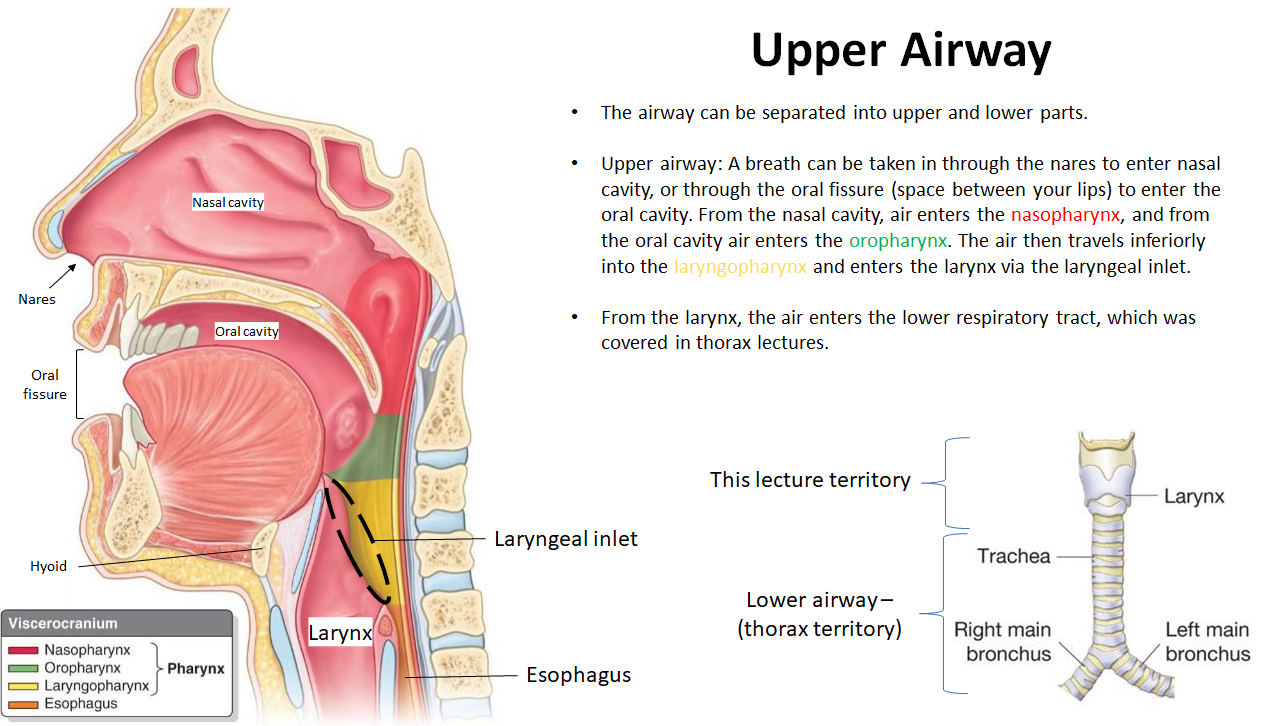
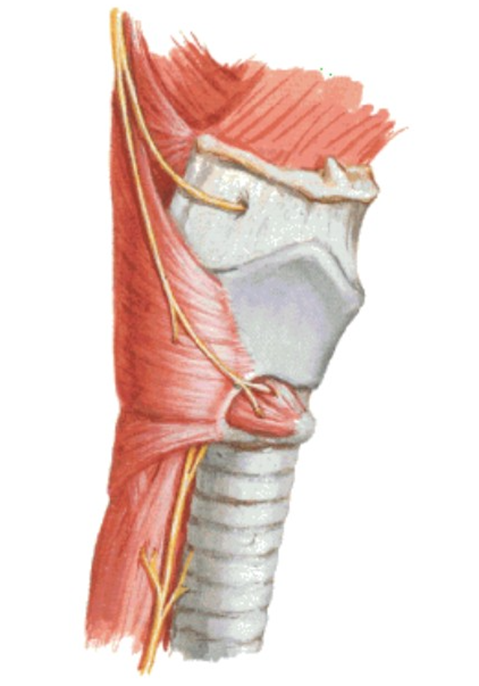
Functions of the larynx?
Located below hyoid, above trachea, in front of esophagus
Allows air from laryngopharynx to trachea
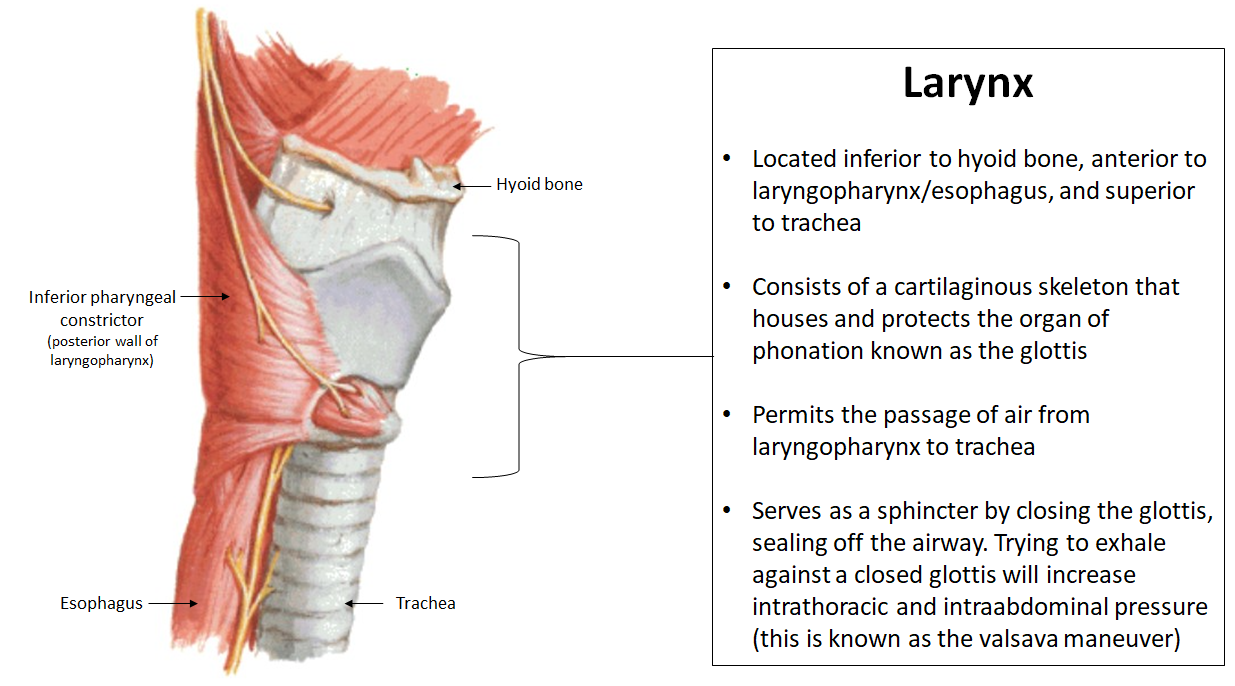
What cartilages make up the laryngeal skeleton?
3 unpaired: thyroid, cricoid, epiglottis
3 paired: arytenoids, corniculates, cuneiforms
Total: 9 cartilages that support and protect the vocal cords
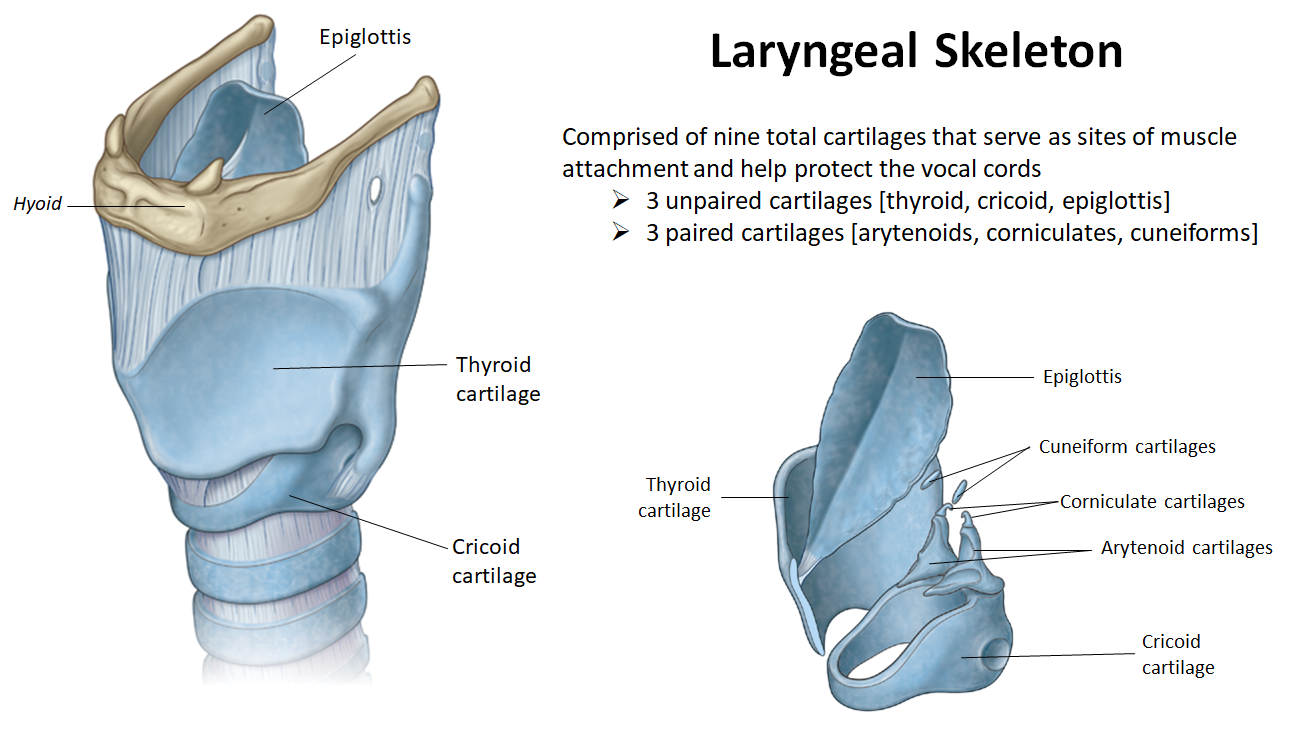

What are key features of the thyroid cartilage?
Largest laryngeal cartilage, shield-shaped
Forms laryngeal prominence “Adam’s apple”
Connects to hyoid via thyrohyoid membrane

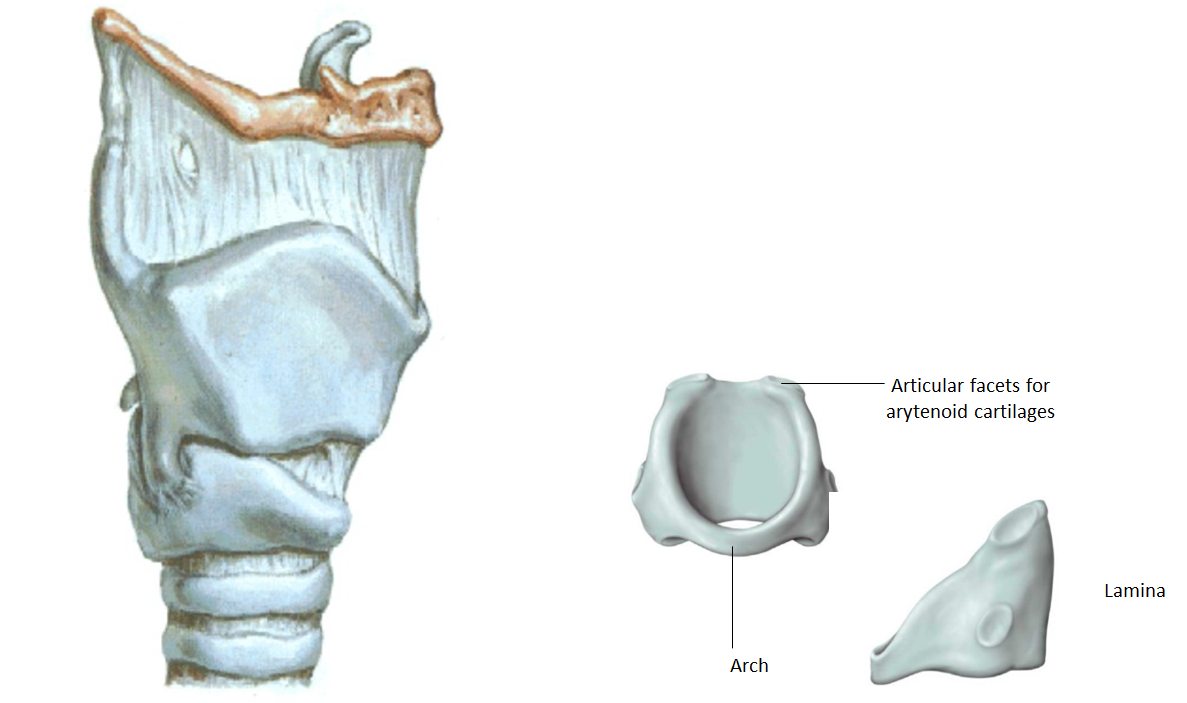
What are key features of the cricoid cartilage?
Located below thyroid, above trachea
Only complete ring of larynx or trachea
Ring-shaped with broad lamina posteriorly, thin arch anteriorly
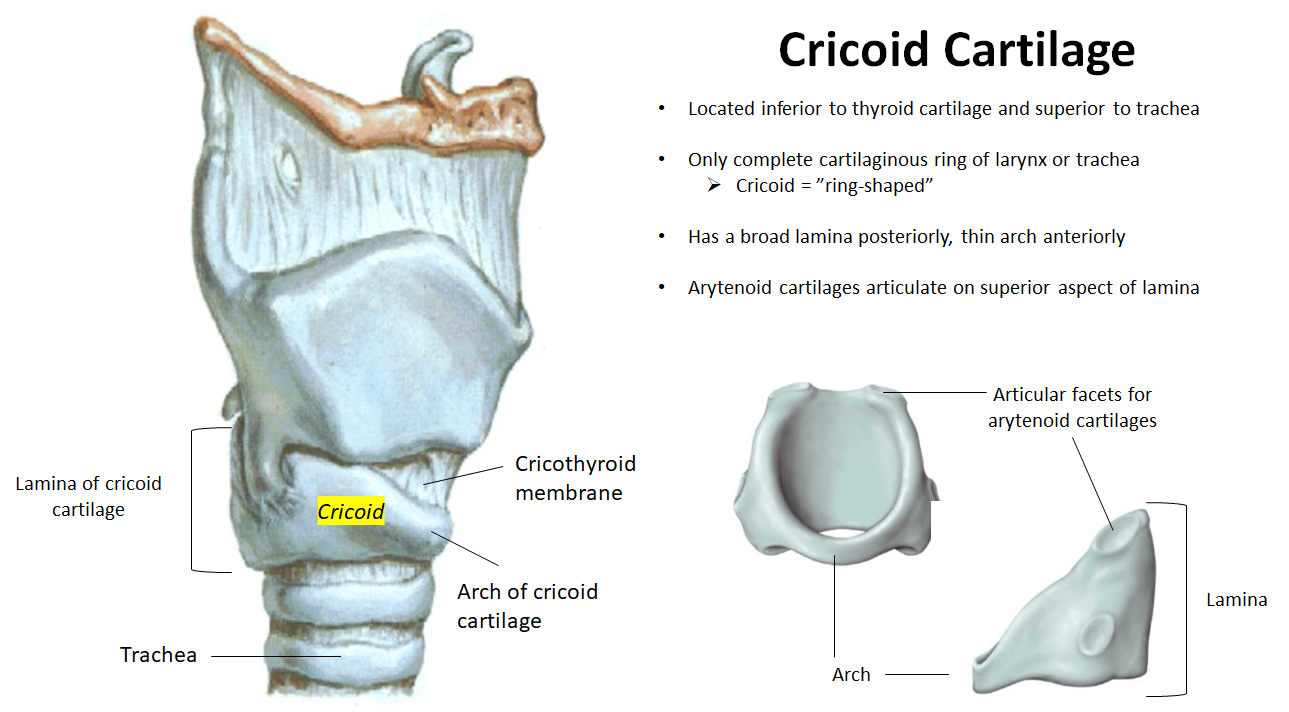
What are the functions of the epiglottis and arytenoid cartilages?
Epiglottis: Attached to the hyoid bone and thyroid cartilage; folds down to block the airway when you swallow.
Arytenoids: Rest on the cricoid cartilage; they rotate to open/close vocal cords and have small corniculate cartilages on top.
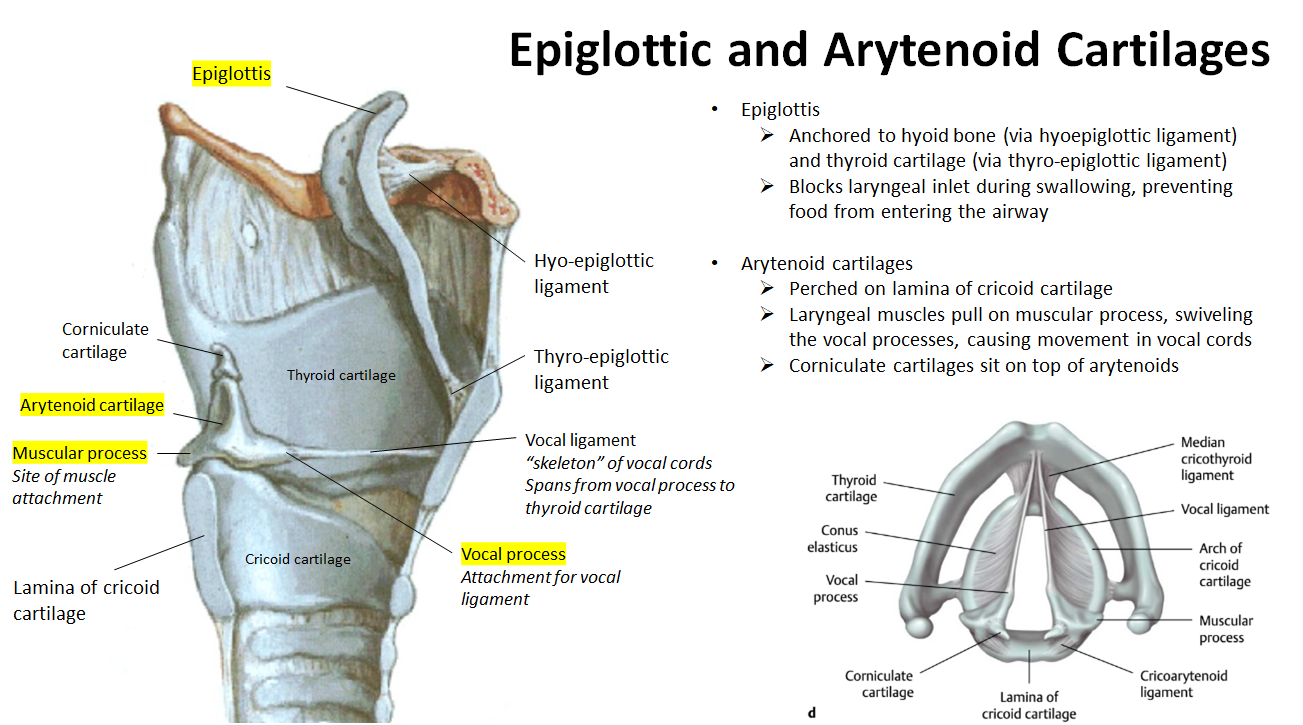
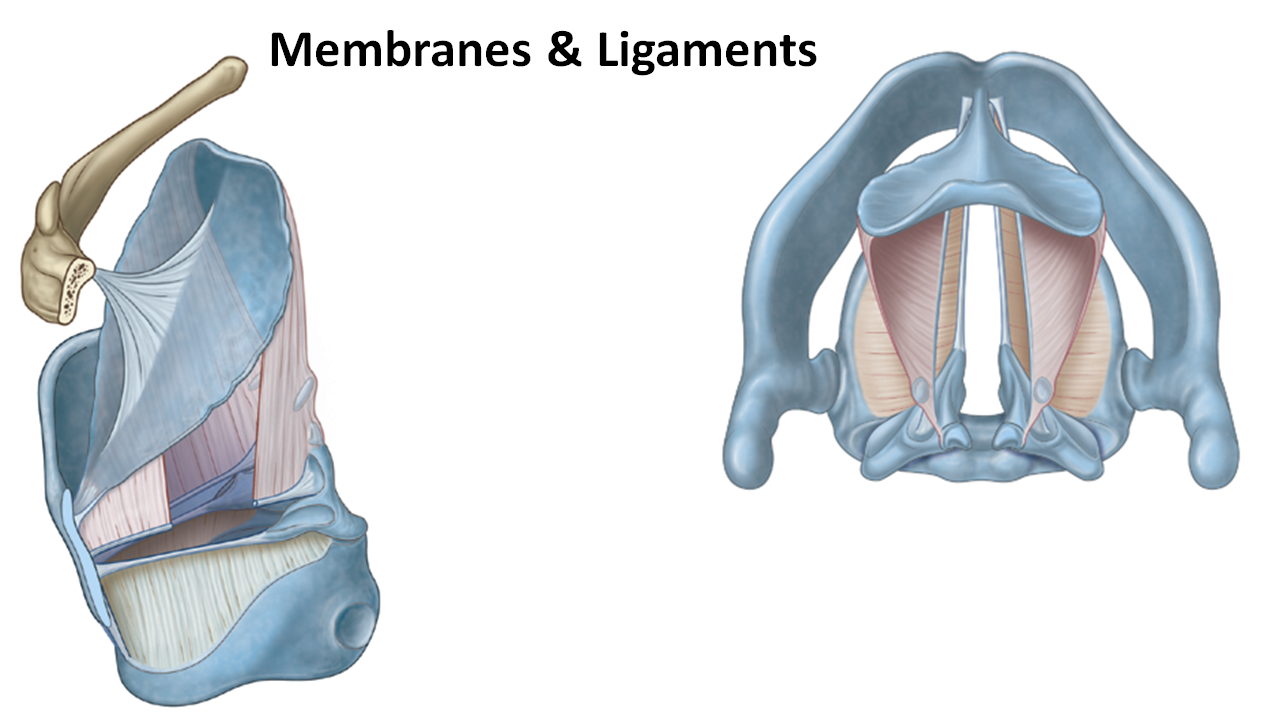
What are the key ligaments and membranes of the larynx?
Vocal ligament: from arytenoid to thyroid cartilage, forms vocal cord
Quadrangular membrane: spans epiglottis to arytenoid; lower edge is vestibular ligament
Conus elasticus: connects cricoid cartilage to vocal ligament
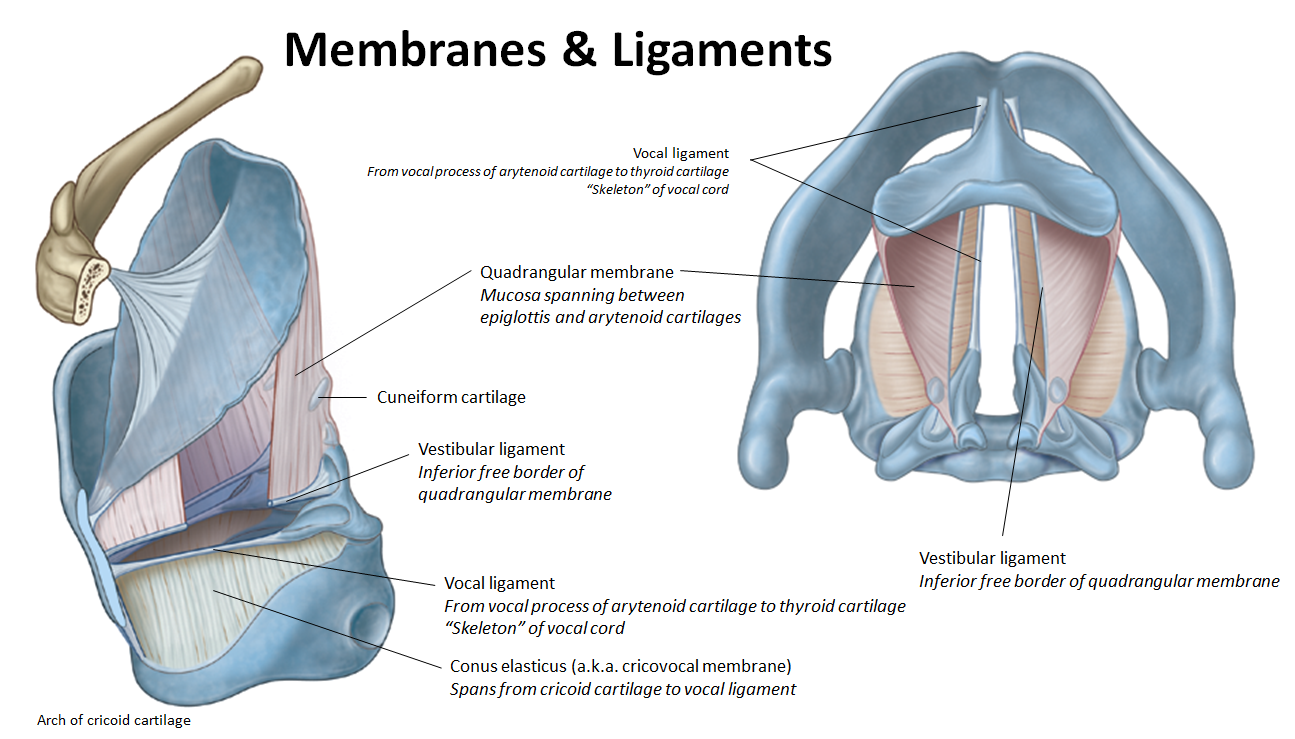
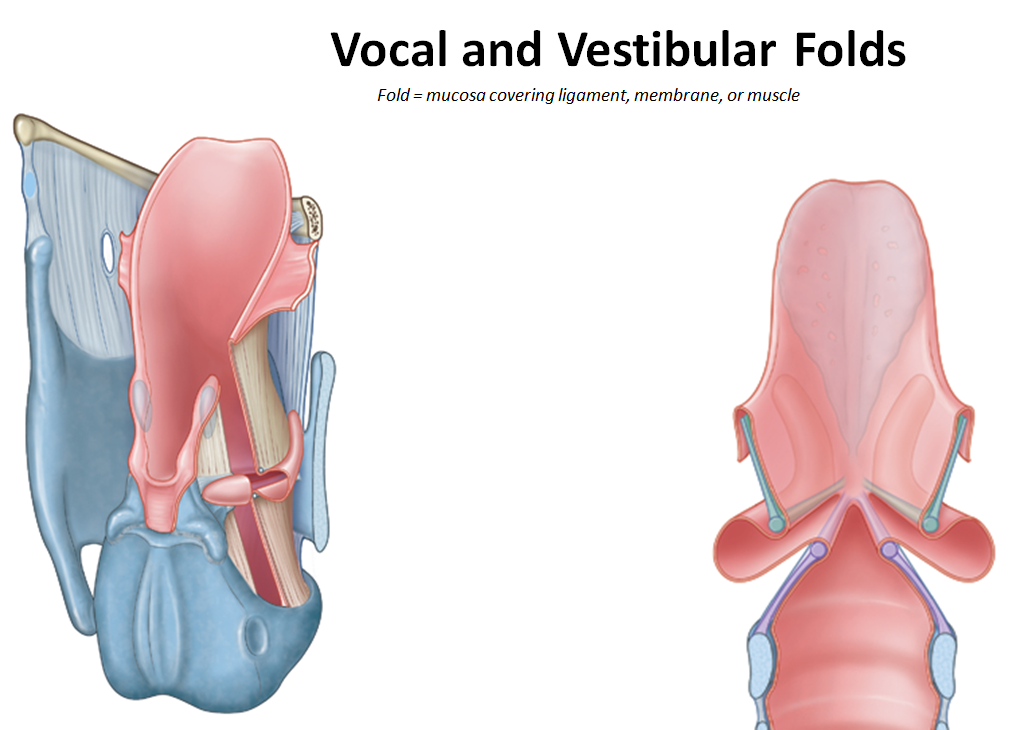
What are vocal and vestibular folds?
Vocal fold (true vocal cord): mucosa covering the vocal ligament
Vestibular fold (false vocal cord): mucosa covering the vestibular ligament
Aryepiglottic fold: superior edge of quadrangular membrane
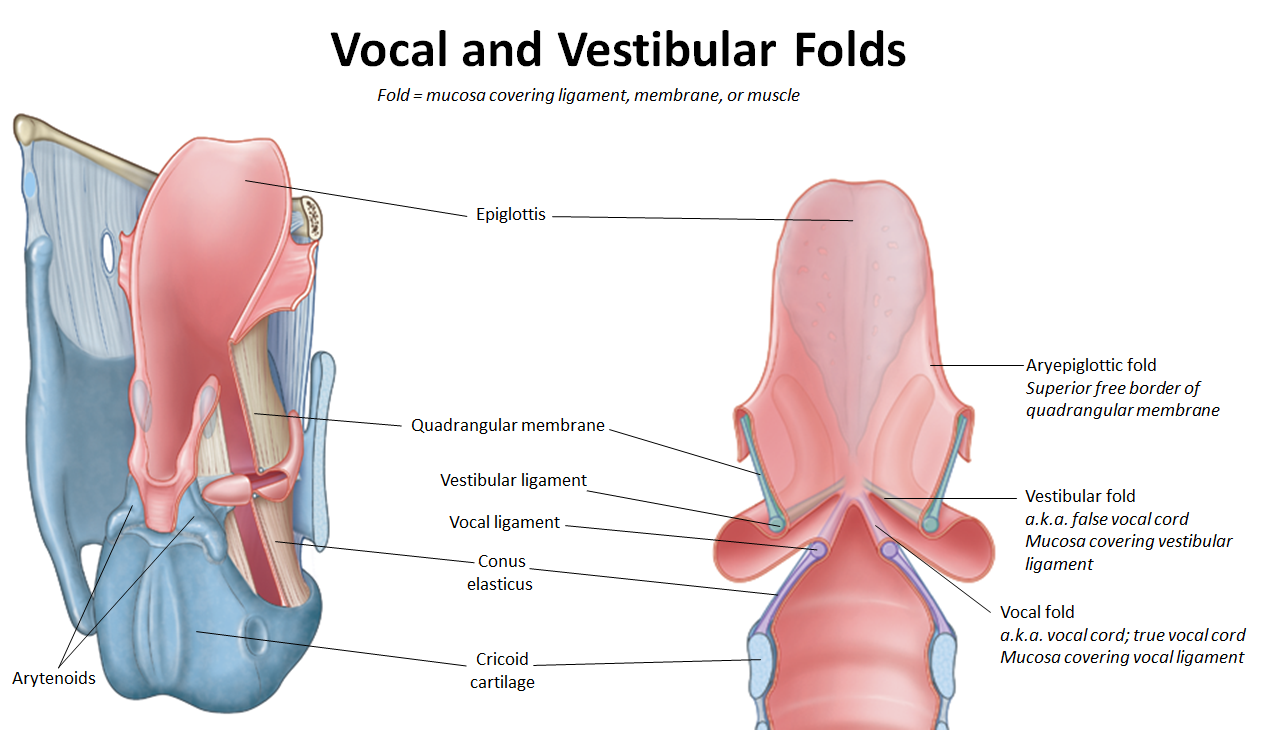
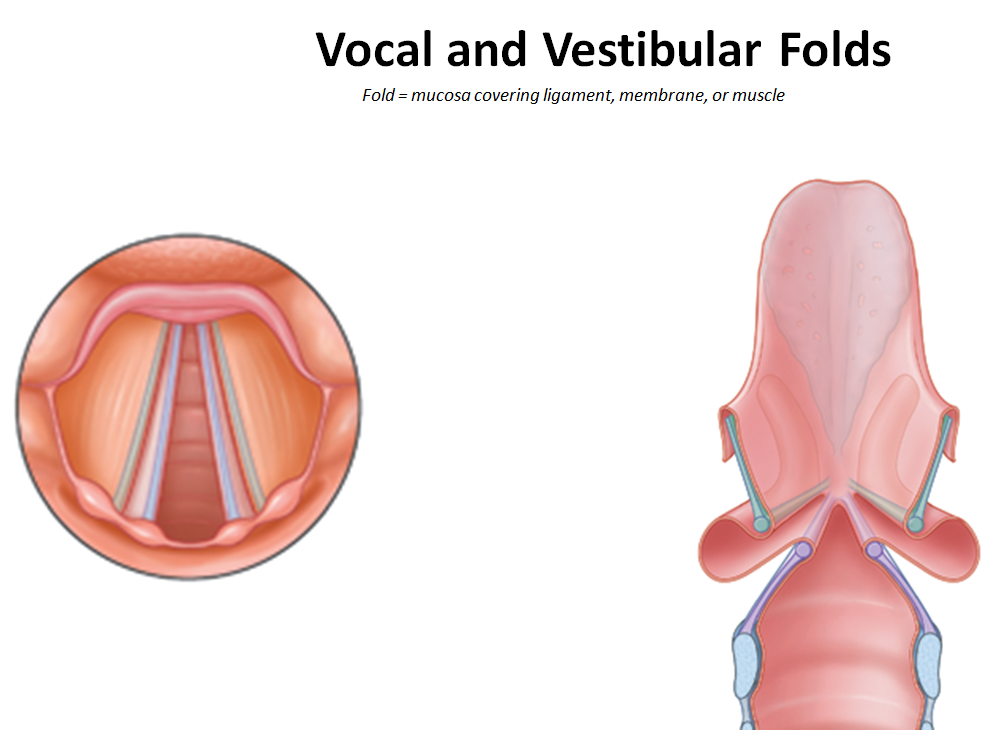
What are the rima vestibuli and rima glottidis?
Rima vestibuli: space between the vestibular folds
Rima glottidis: space between the vocal folds
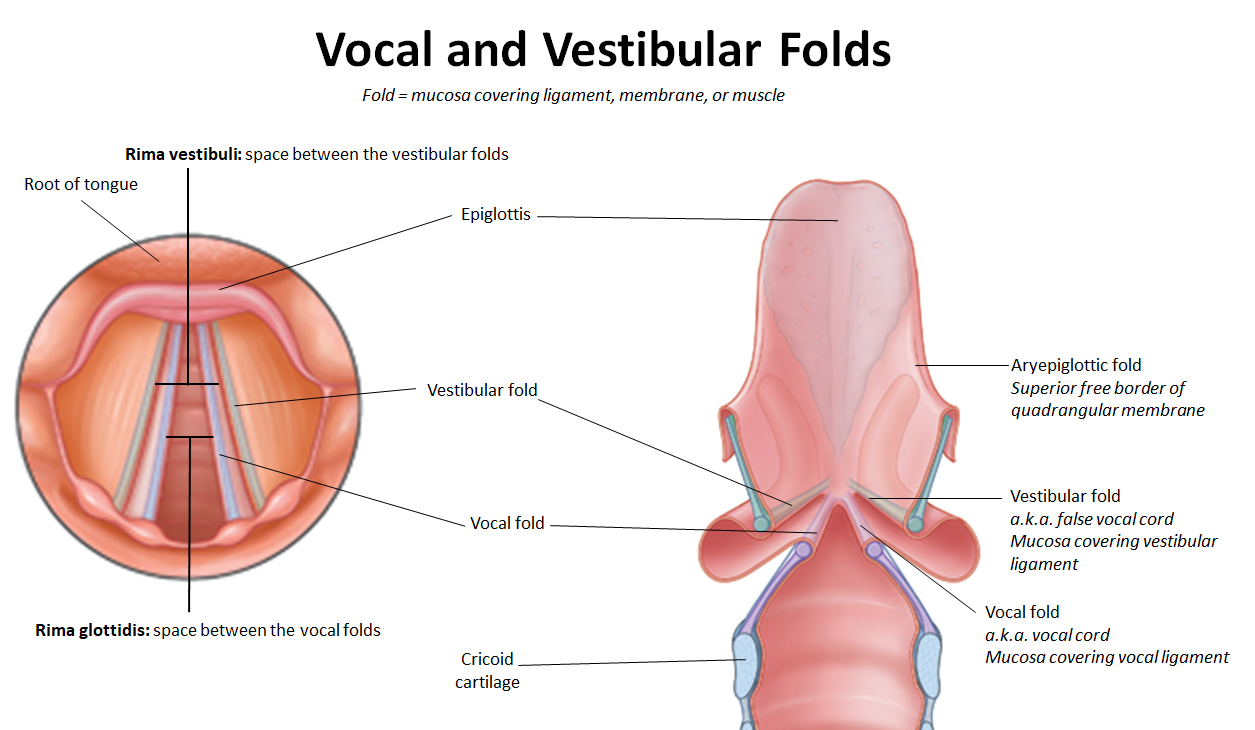
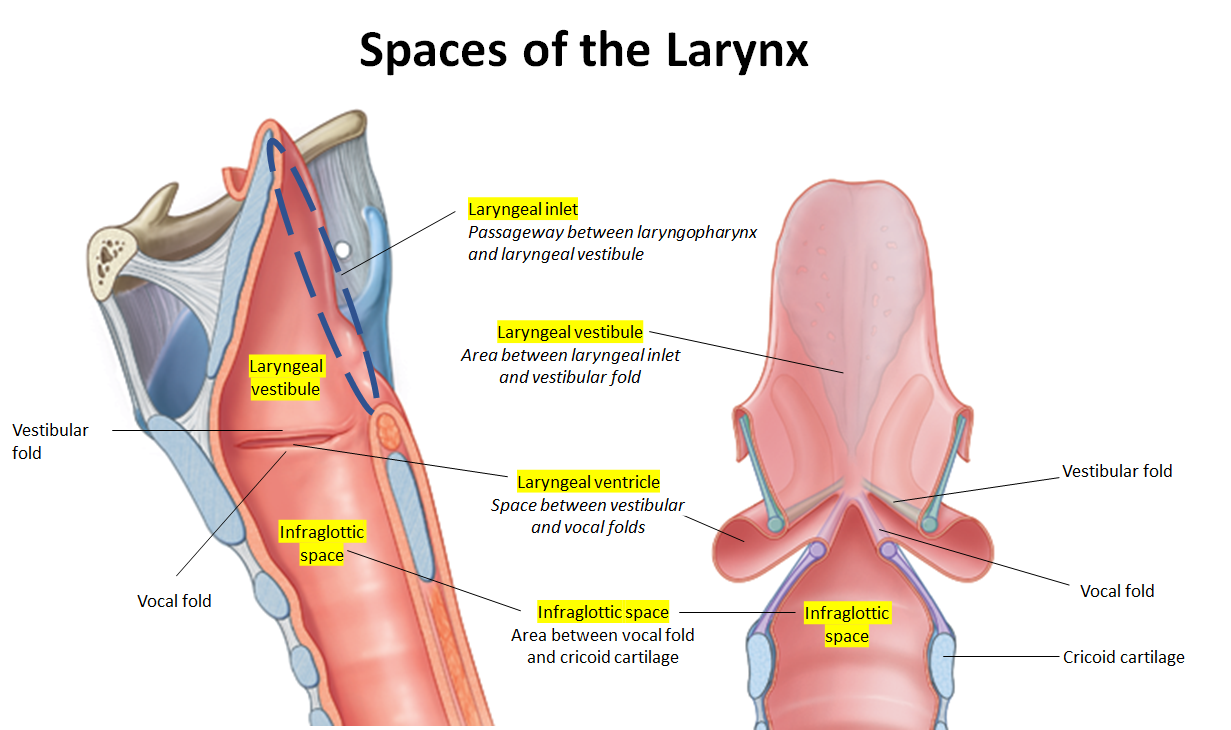
What are the key spaces of the larynx?
Laryngeal inlet: opening from laryngopharynx to laryngeal vestibule
Laryngeal vestibule: between inlet and vestibular folds
Laryngeal ventricle: between vestibular and vocal folds
Infraglottic space: between vocal folds and cricoid cartilage
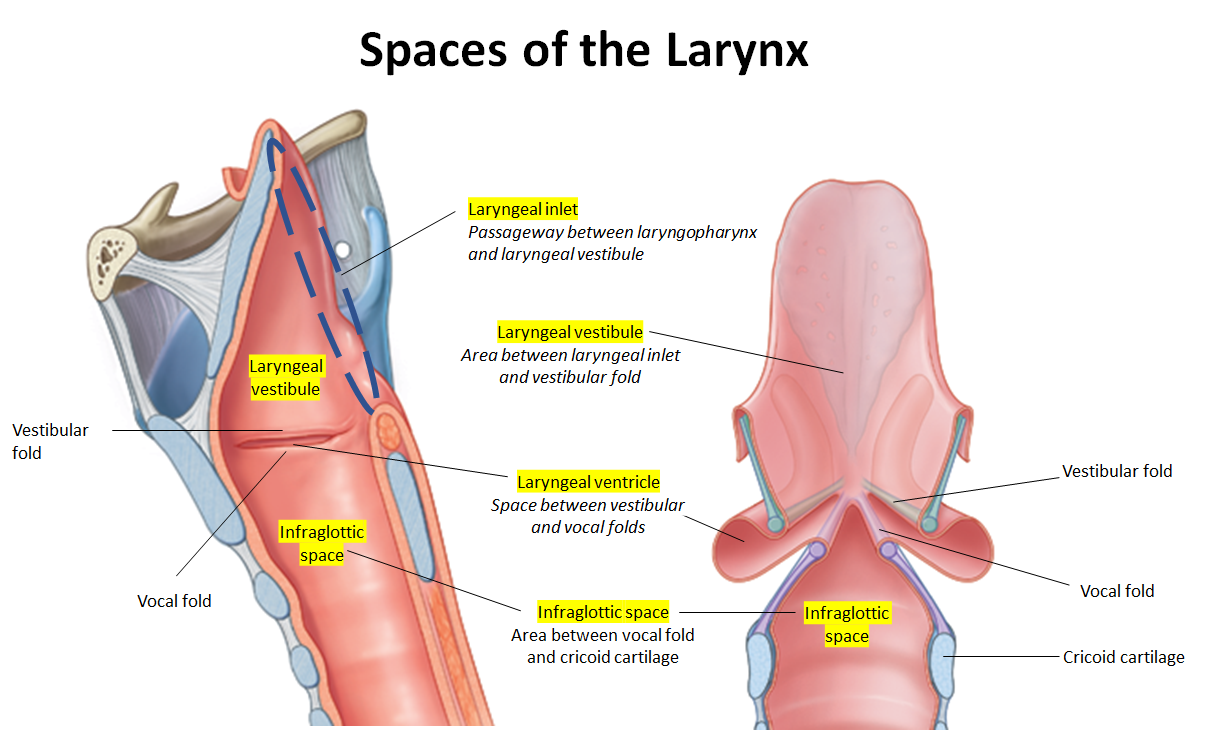
What are the two main joints of the larynx and their functions?
Cricothyroid joint: tilts thyroid cartilage forward, tightens vocal cords, raises pitch
Cricoarytenoid joint: moves arytenoids to open/close vocal cords, adjusts rima glottidis size
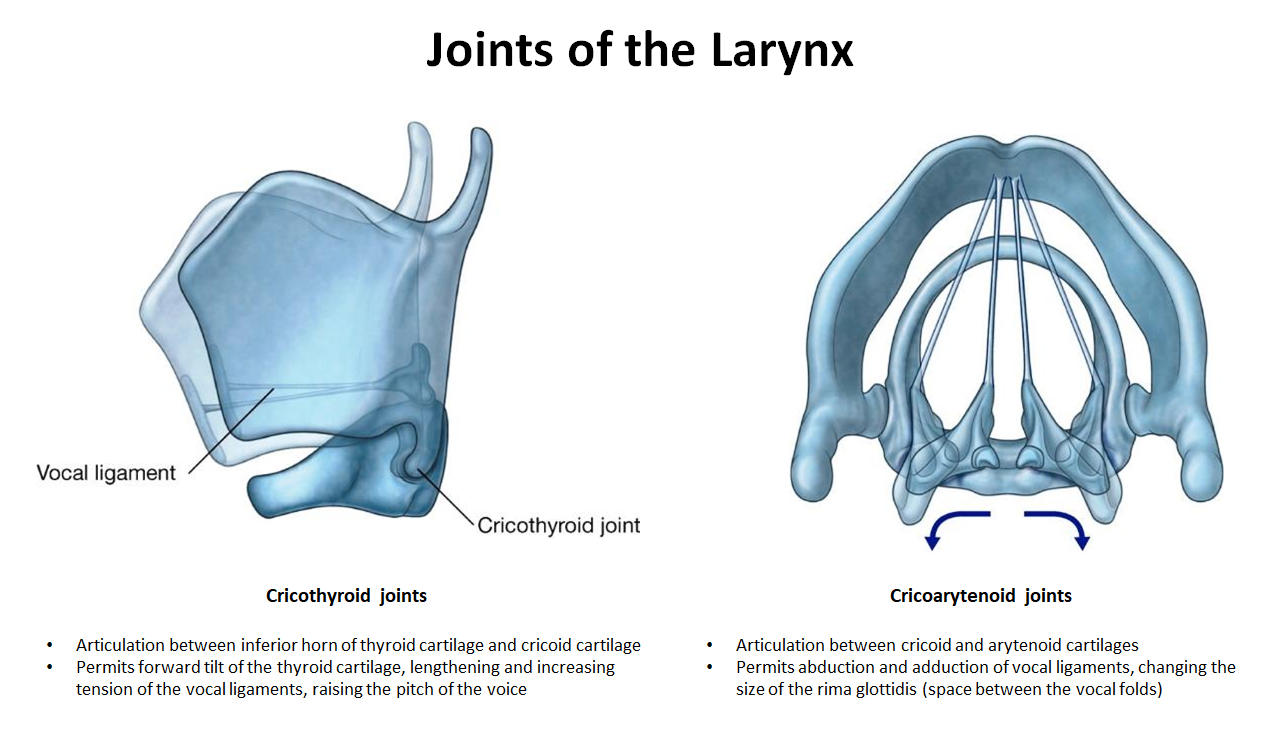
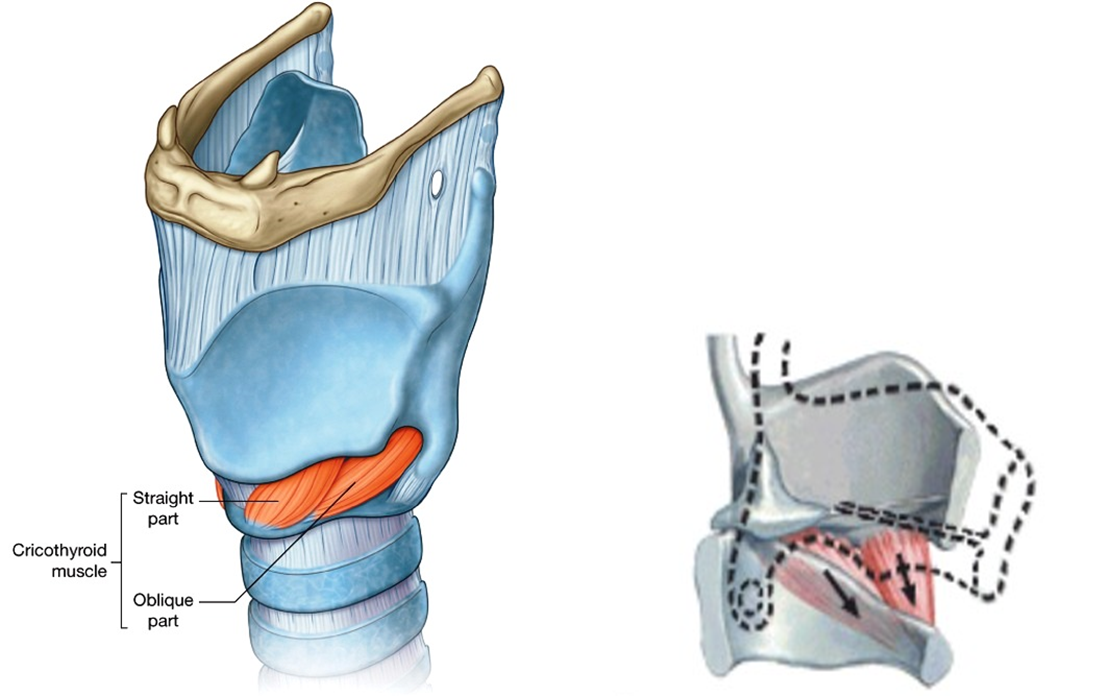
What is the function and innervation of the cricothyroid muscle?
Function: pulls thyroid cartilage forward, tightens vocal cords, raises pitch
Innervation: external branch of the superior laryngeal nerve (only intrinsic laryngeal muscle not innervated by recurrent laryngeal nerve)
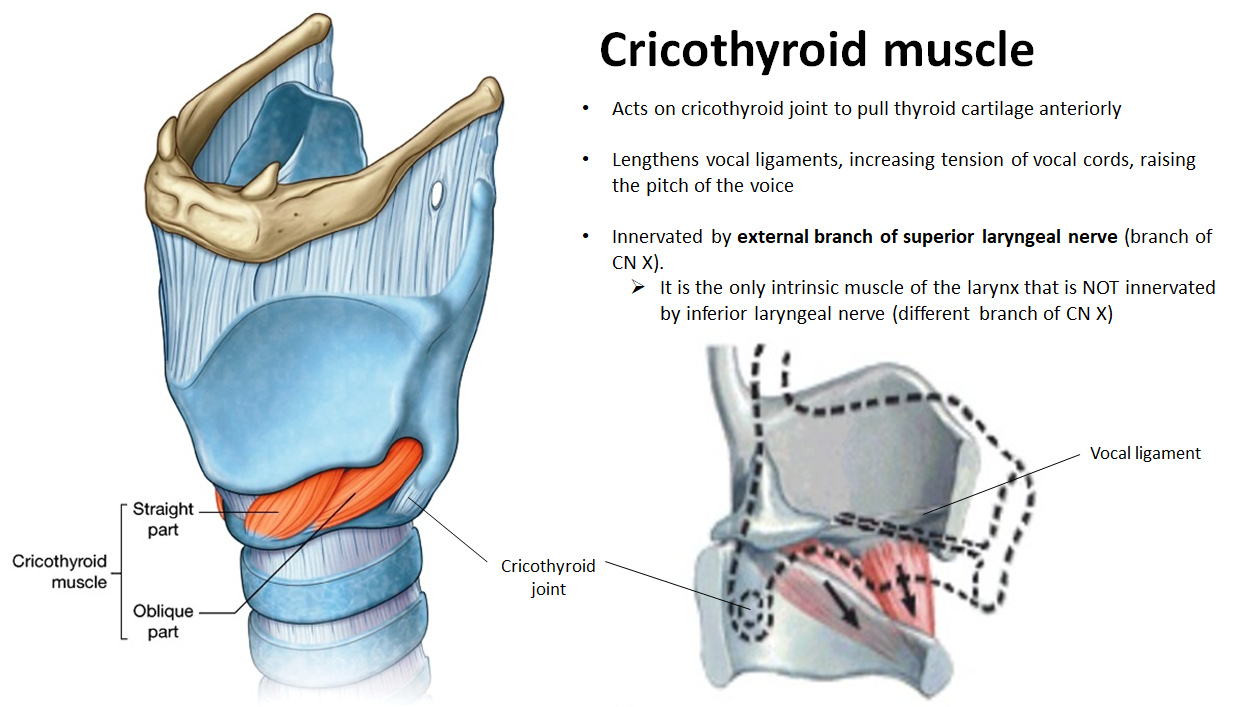
What are the actions and innervation of the intrinsic laryngeal muscles?
Thyroarytenoid: shortens vocal folds, decreases tension
Vocalis: fine-tunes vocal fold tension
Transverse/Oblique arytenoids, Lateral cricoarytenoid: adduct vocal folds
Posterior cricoarytenoid: abducts vocal folds
All are innervated by the inferior laryngeal nerve (branch of CN X).


What is the action and innervation of the thyroarytenoid muscle?
Action: Pulls arytenoids forward to shorten vocal folds, lowering tension and pitch.
Innervation: Inferior laryngeal nerve (branch of CN X).


What is the action and innervation of the vocalis muscle?
Action: Fine-tunes vocal fold tension during speech and singing
Innervation: Inferior laryngeal nerve (branch of CN X)


What is the action and innervation of the transverse and oblique arytenoid muscles?
Action: Adduct vocal folds by pulling arytenoid cartilages together
Innervation: Inferior laryngeal nerve (branch of CN X)
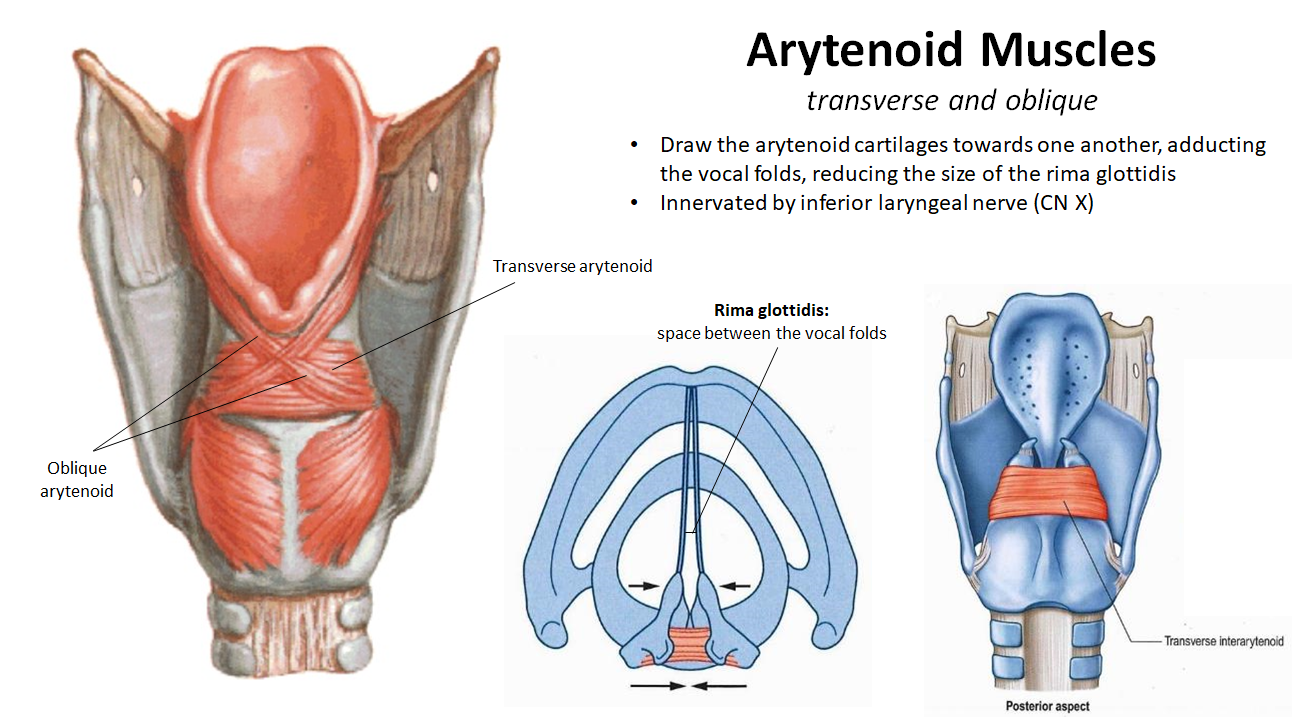
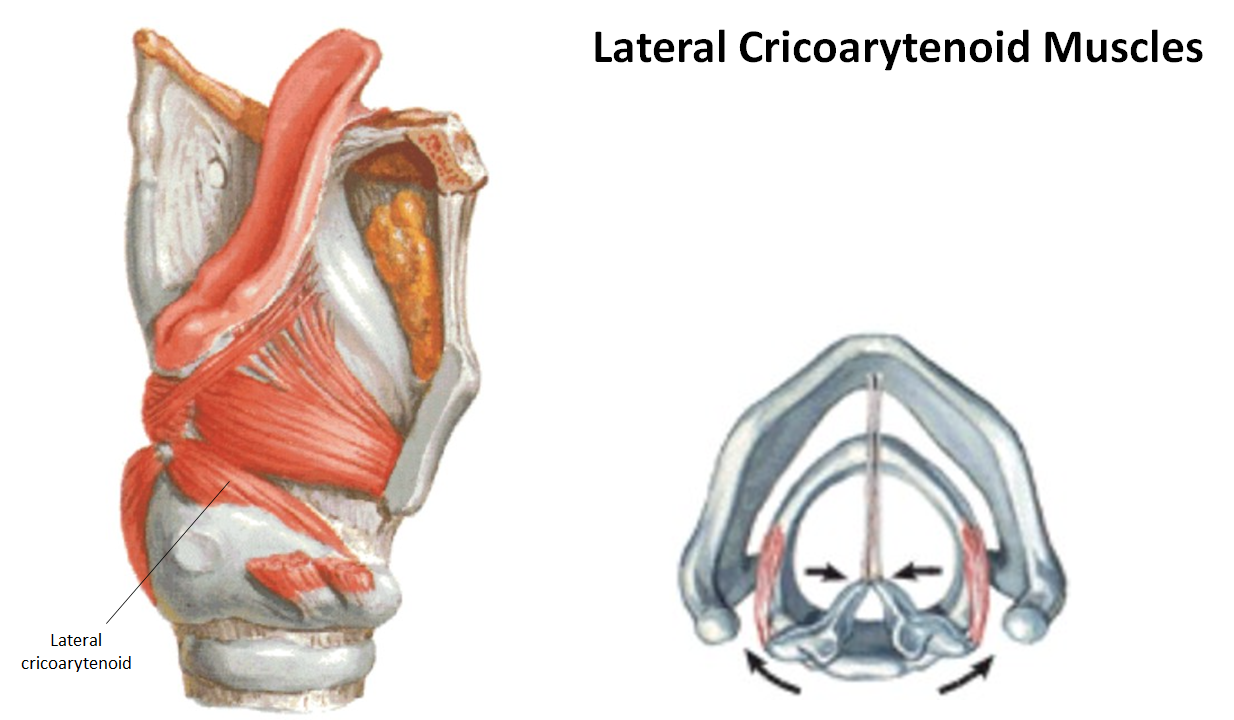
What is the action and innervation of the lateral cricoarytenoid muscles?
Action: Adduct vocal folds by rotating arytenoids medially
Innervation: Inferior laryngeal nerve (branch of CN X)
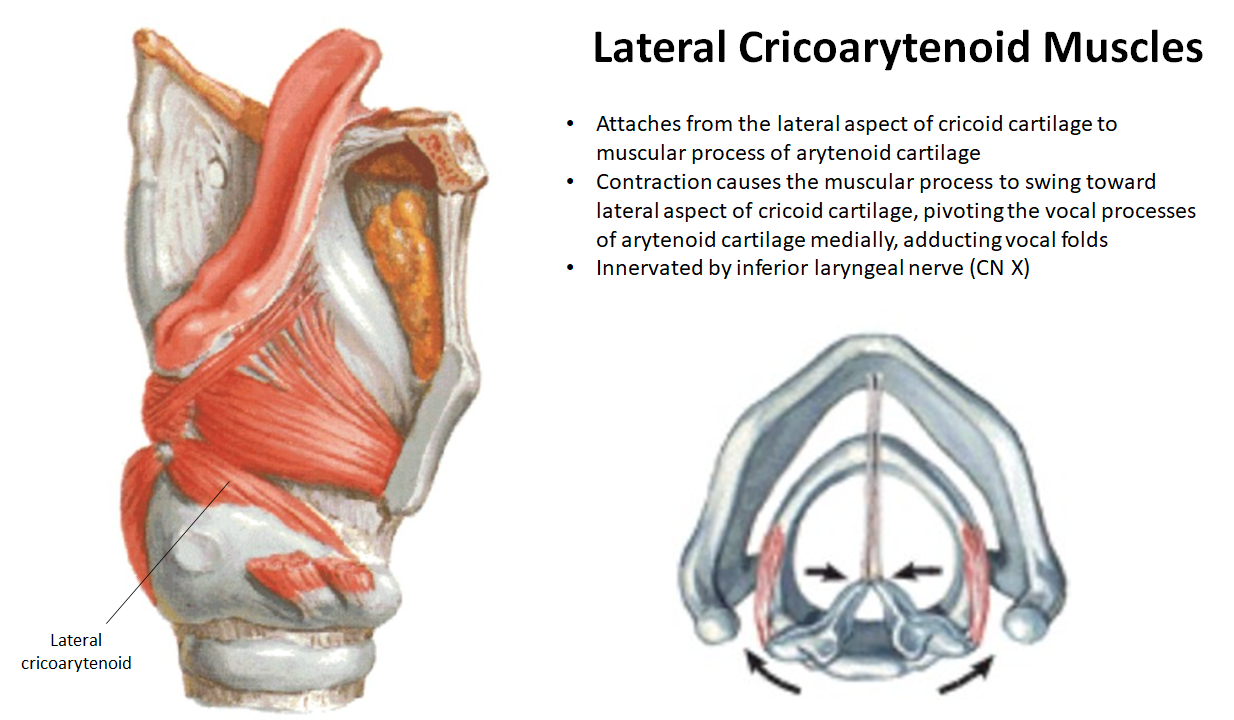
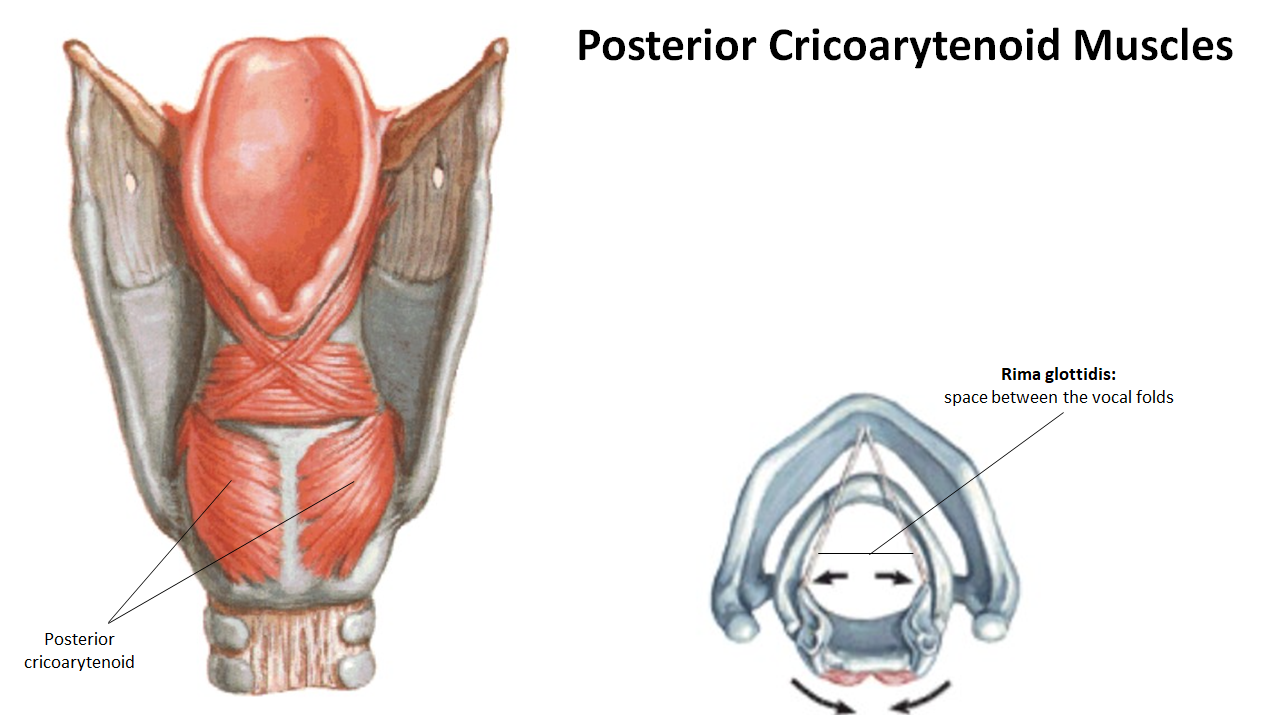
What is the action and innervation of the posterior cricoarytenoid muscles?
Action: Abduct vocal folds; only muscle that opens rima glottidis
Innervation: Inferior laryngeal nerve (branch of CN X)
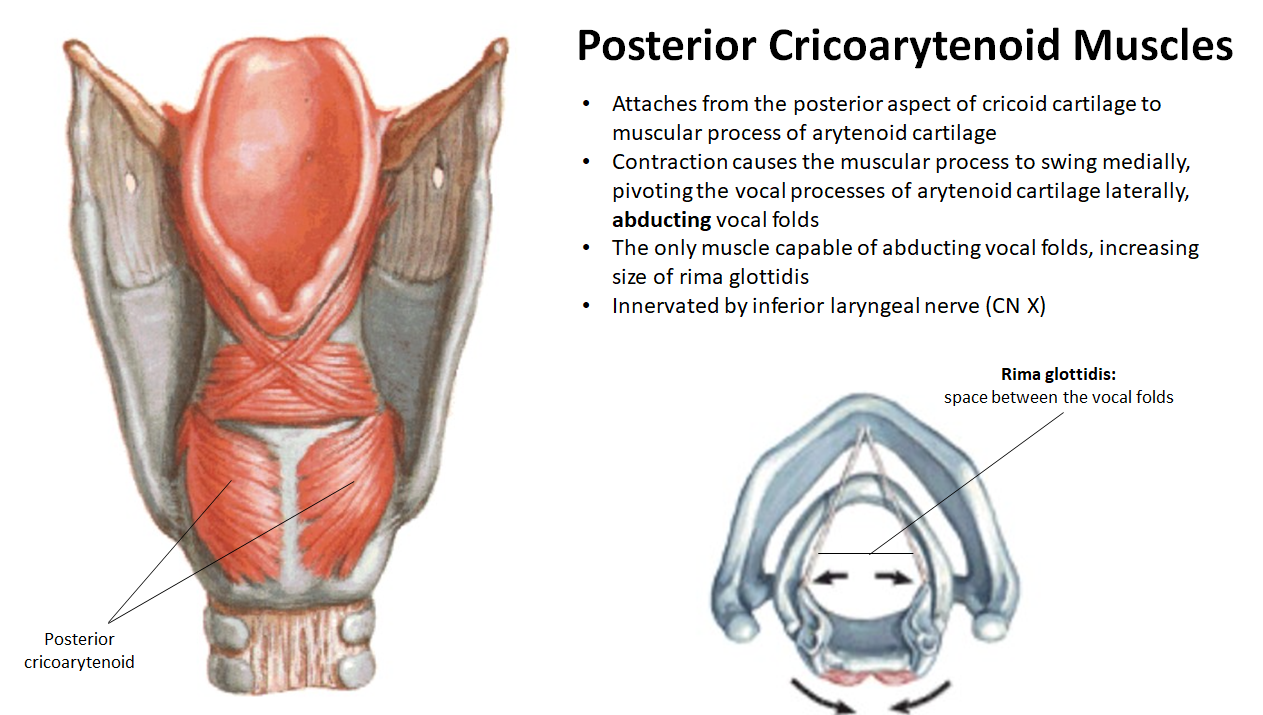
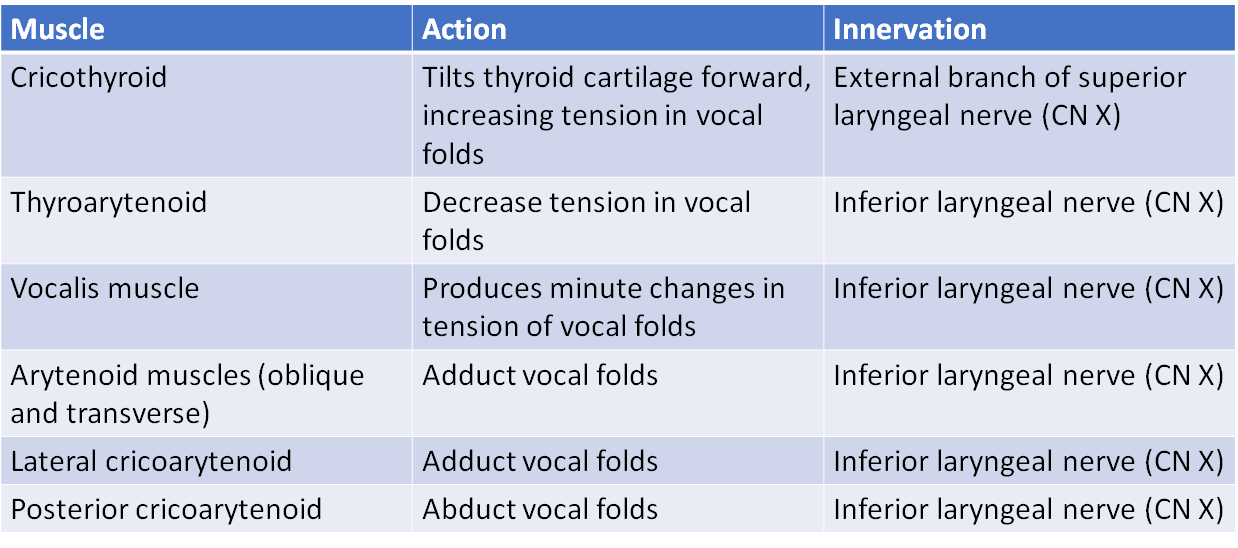
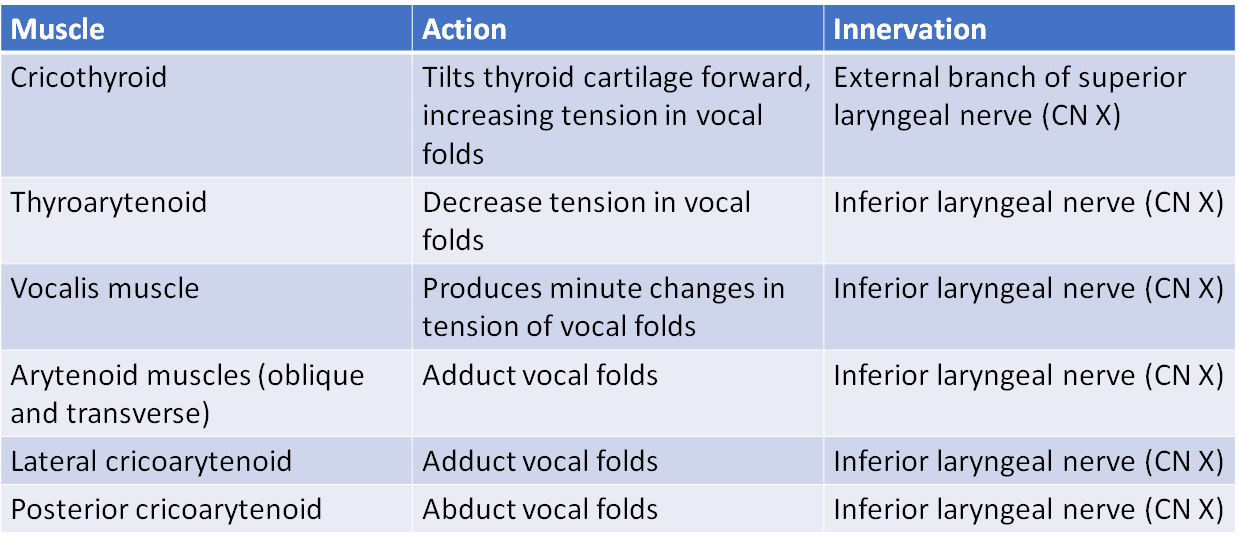
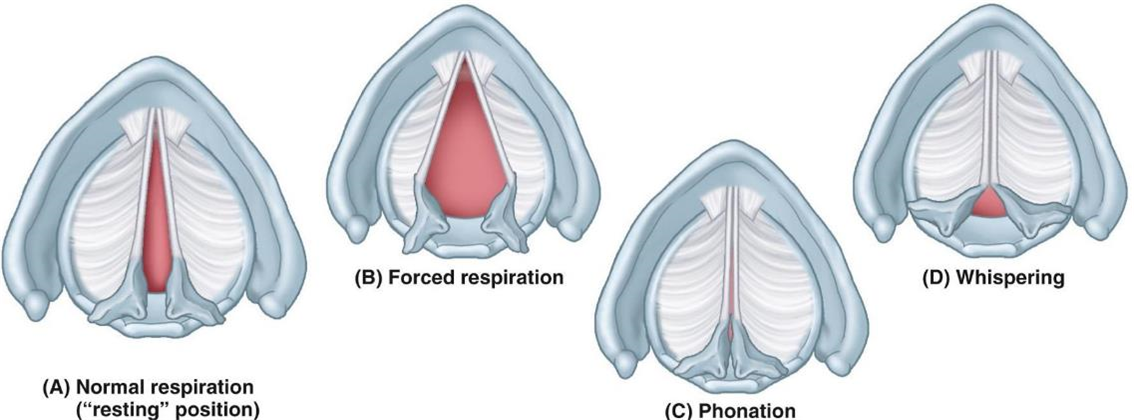
How do laryngeal muscles contribute to respiration and speech?
Forced respiration: Posterior cricoarytenoids abduct vocal folds
Phonation: Adducted vocal folds vibrate to produce tone
Whispering: Vocal folds adduct, but arytenoids stay apart to allow airflow without tone
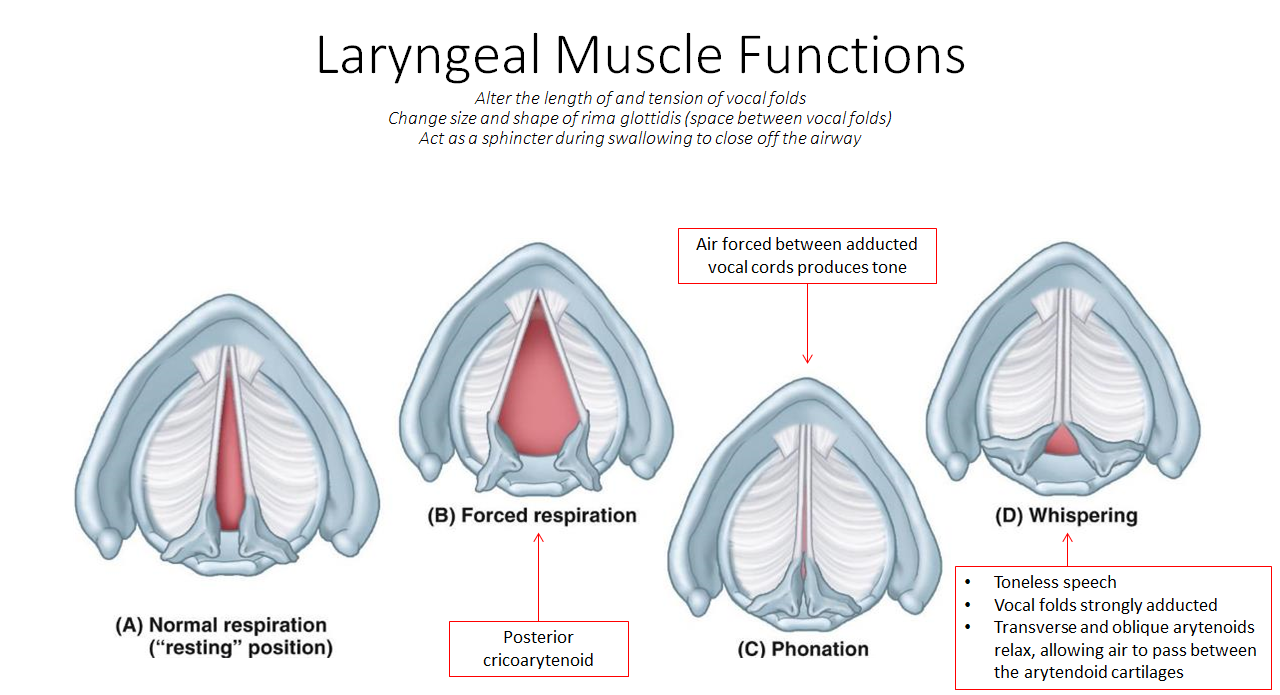

What nerves provide sensory innervation to the larynx above and below the vocal folds?
Above vocal folds (including them): Internal branch of superior laryngeal nerve
Below vocal folds: Inferior laryngeal nerve
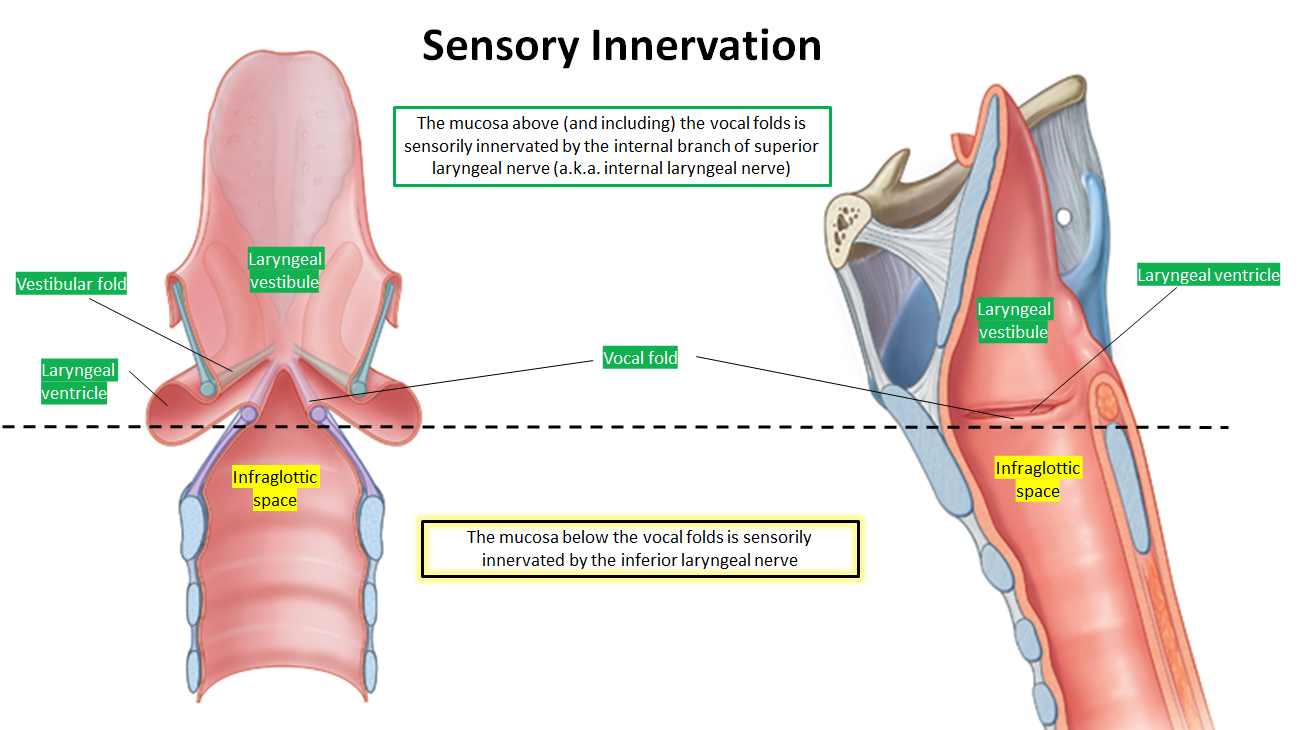
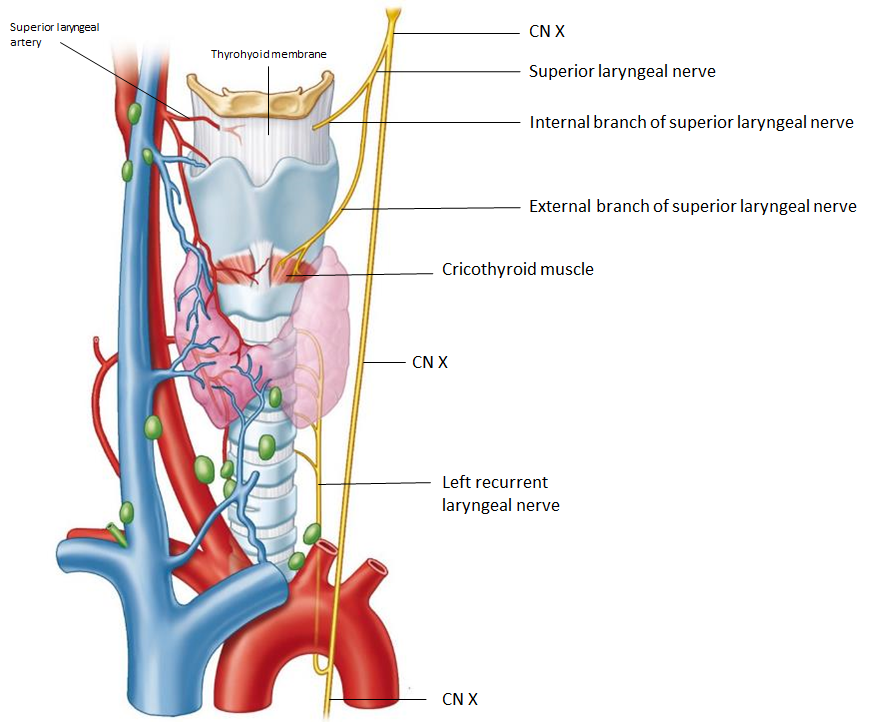
What are the motor and sensory roles of the laryngeal nerves derived from CN X (vagus)?
External branch of superior laryngeal nerve: motor to cricothyroid
Internal branch of superior laryngeal nerve: sensory above vocal folds
Inferior laryngeal nerve: motor to all other intrinsic muscles, sensory below vocal folds


What is the relationship between the recurrent and inferior laryngeal nerves?
The inferior laryngeal nerve is the continuation of the recurrent laryngeal nerve after it passes the cricothyroid joint.
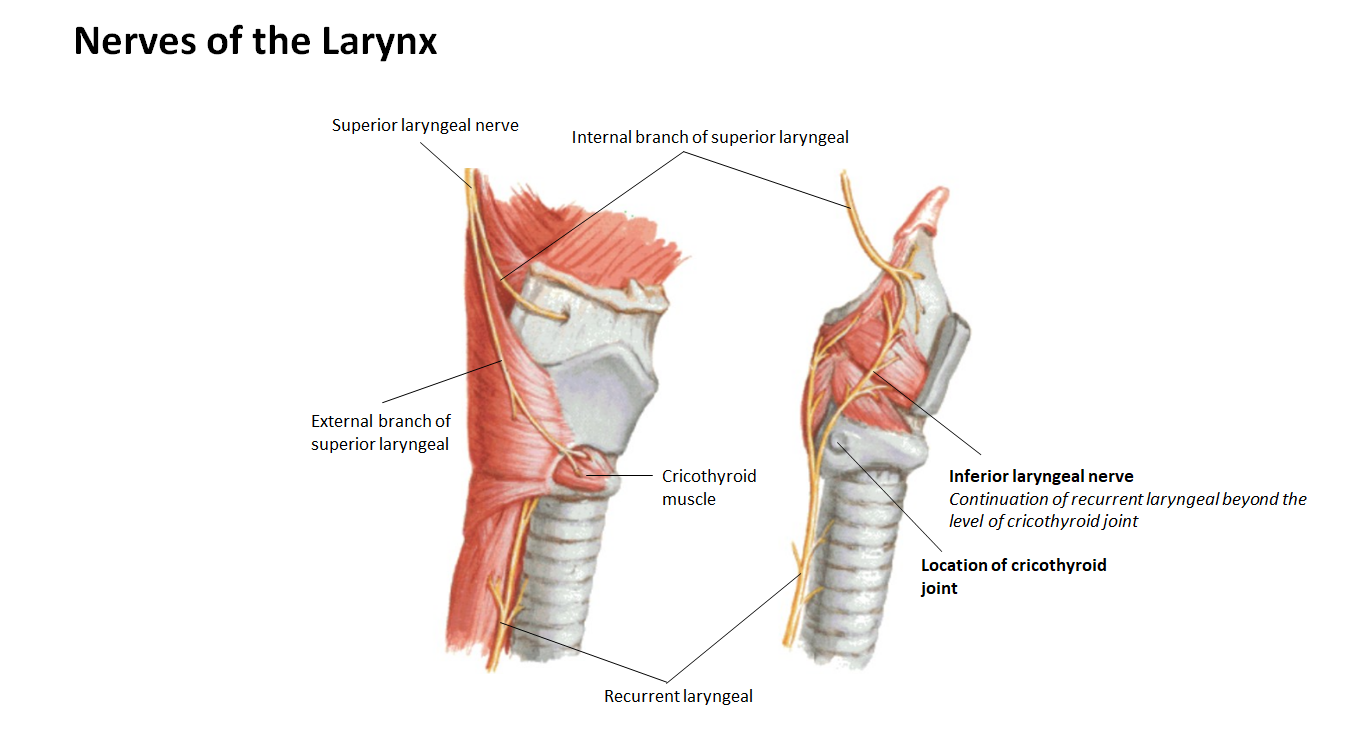
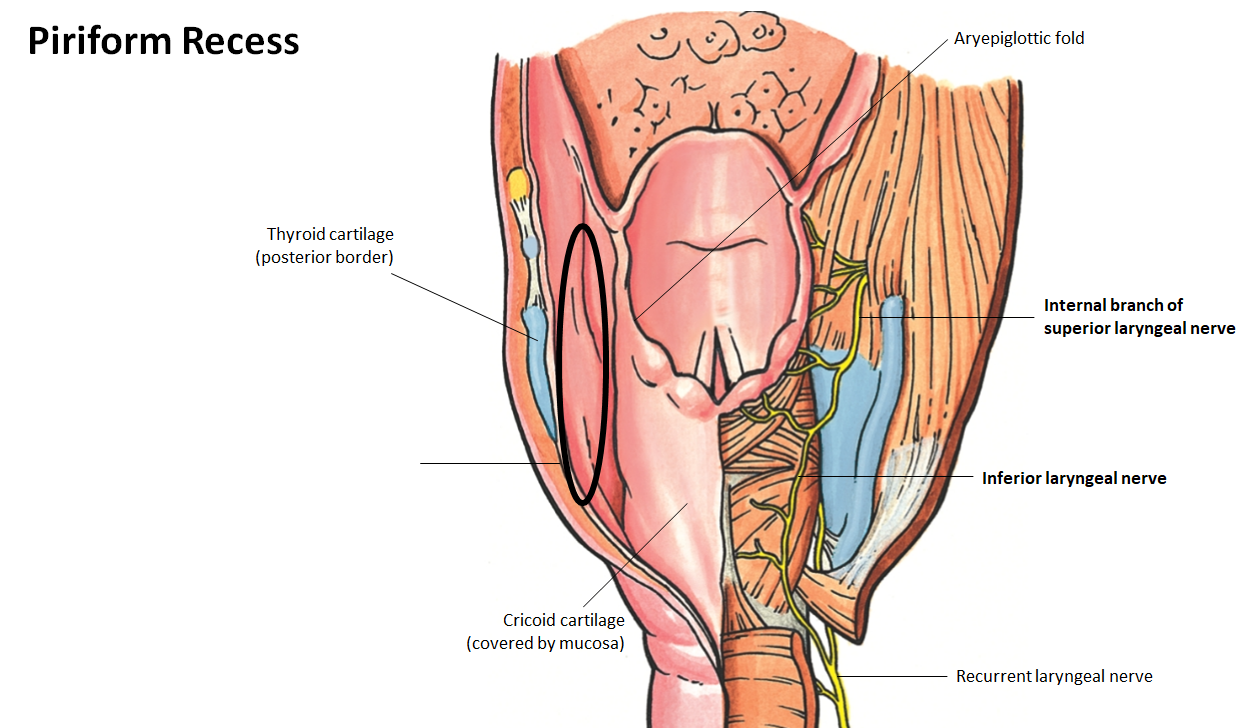
What is the clinical importance of the piriform recess?
Food or pills can lodge here after swallowing; internal and inferior laryngeal nerves lie deep to its mucosa and are at risk if injured.
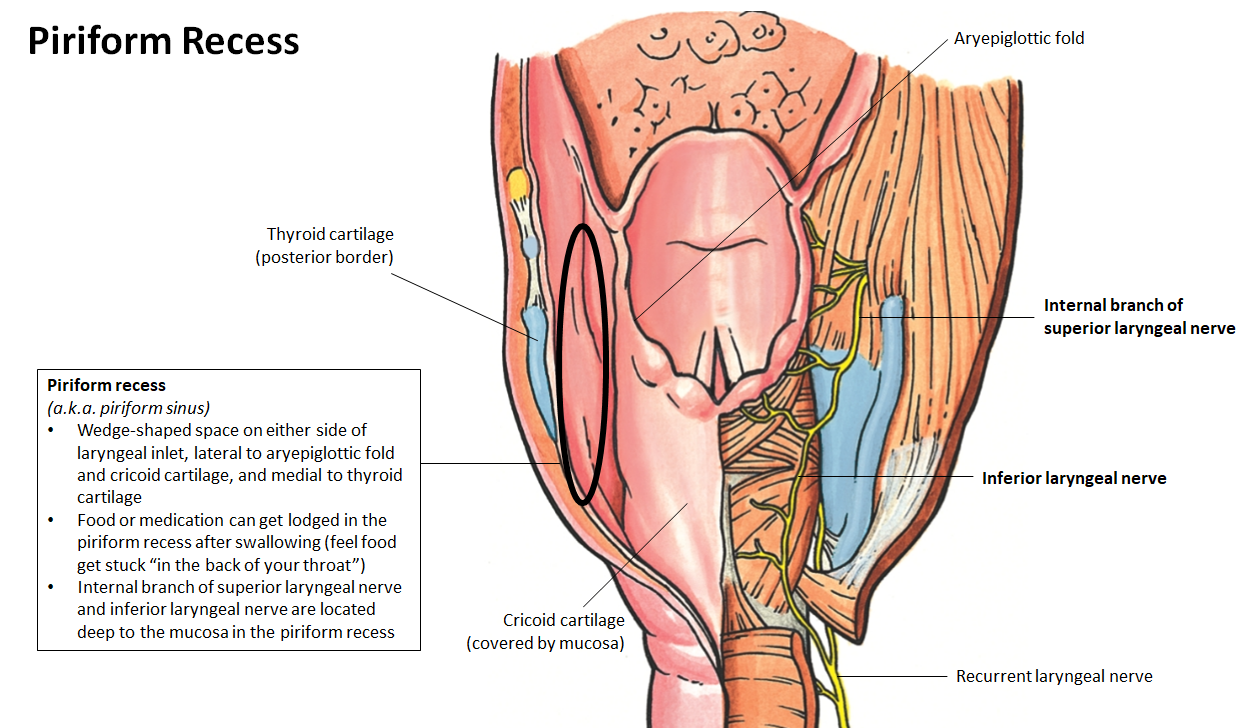
What are the laryngeal arteries and what do they accompany?
The superior laryngeal artery (from external carotid) enters via the thyrohyoid membrane with the internal branch of the superior laryngeal nerve.
The inferior laryngeal artery (from subclavian) enters with the recurrent laryngeal nerve.
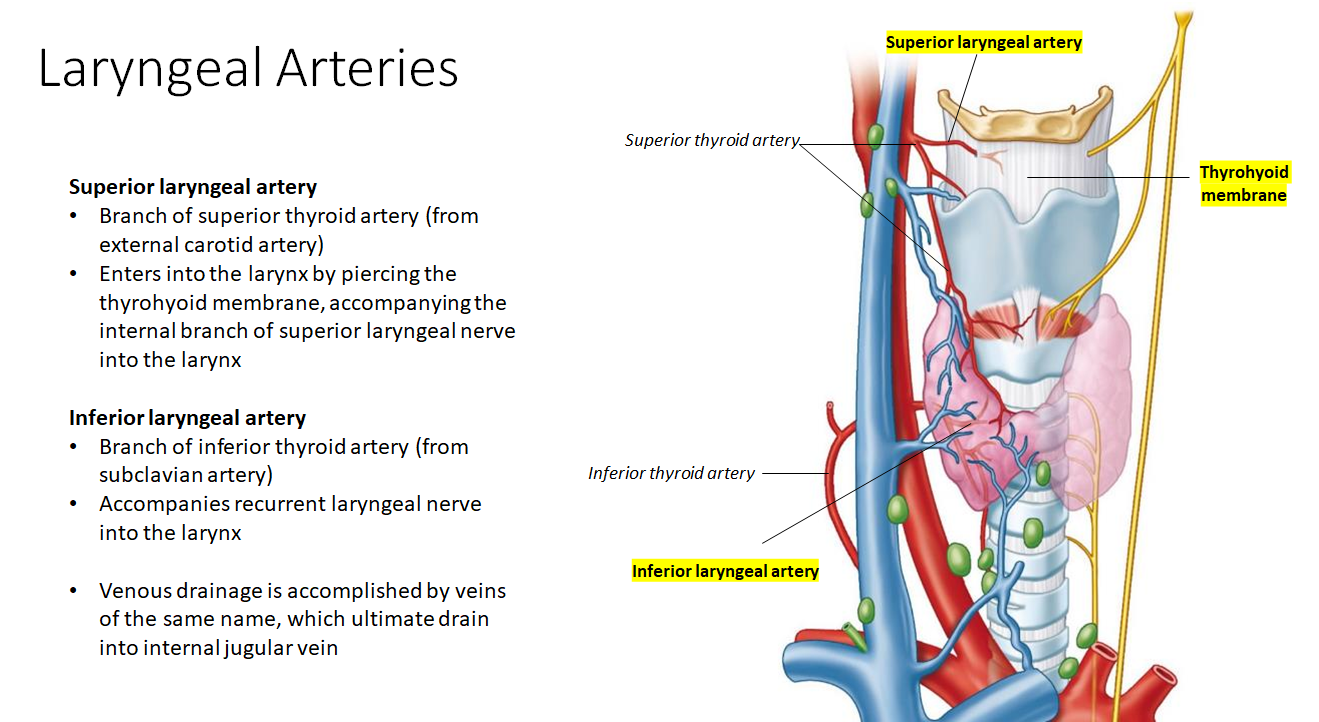
How does lymph from the larynx drain based on the vocal fold level?
Above the vocal folds, lymph drains through the thyrohyoid membrane to superior deep cervical lymph nodes.
Below the vocal folds, lymph drains into pretracheal/paratracheal nodes, then to inferior deep cervical lymph nodes.

A 30-year-old female undergoes a biopsy of the thyroid gland. During the procedure, the recurrent laryngeal nerve was damaged. This injury would most likely cause the sensory innervation in which location to be diminished?
Infraglottic space
Laryngeal inlet
Laryngeal ventricle
Laryngopharynx
Vestibular fold
Infraglottic space
The recurrent laryngeal nerve is responsible for:
Motor innervation to most of the intrinsic muscles of the larynx (except the cricothyroid).
Sensory innervation to the infraglottic space, which is the area below the vocal cords.
Damage to this nerve, such as during a thyroid biopsy, would diminish sensation in the infraglottic space.

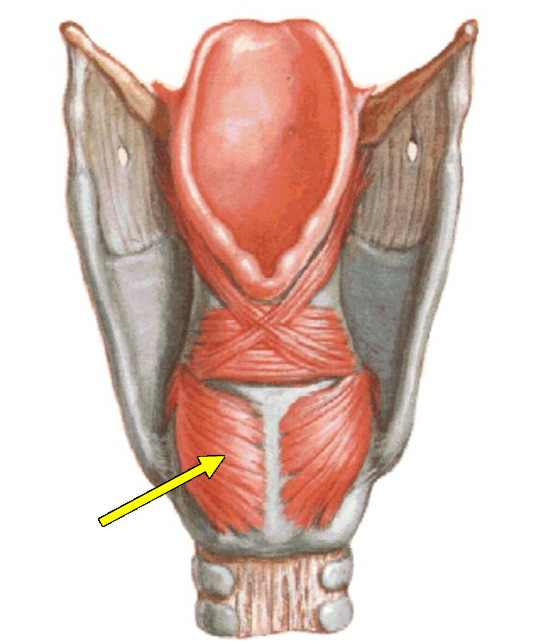
The muscle indicated by the arrow has which primary action on the vocal folds?
Abduction
Adduction
Decreasing tension
Increasing tension
Minute changes in tension
Abduction (posterior cricoarytenoid)
The posterior cricoarytenoid muscle is the only muscle that abducts the vocal folds, meaning it opens the glottis (space between the vocal cords).
It’s important for breathing, as it allows air to pass through the larynx.
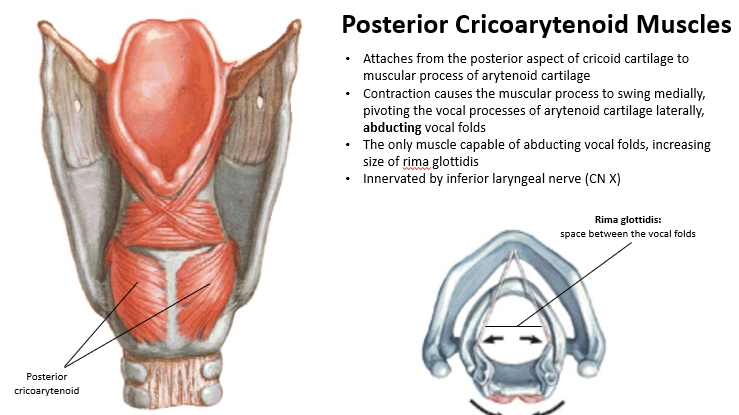
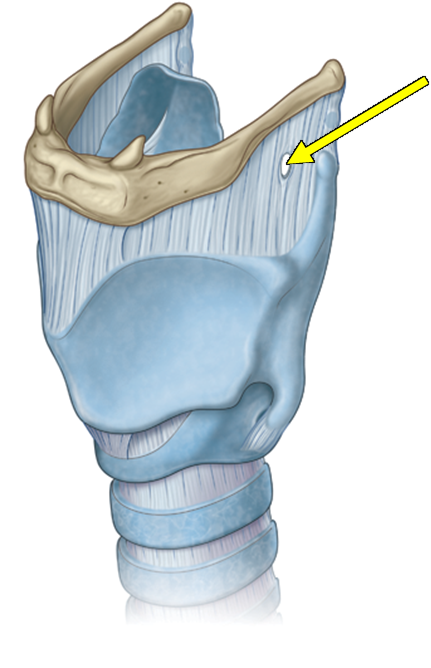
Which structure enters the larynx by piercing the structure indicated by the arrow?
External branch of superior laryngeal nerve
Recurrent laryngeal nerve
Inferior laryngeal artery
Superior laryngeal artery
Superior thyroid artery
Superior laryngeal artery
The arrow points to the thyrohyoid membrane. The superior laryngeal artery, along with the internal branch of the superior laryngeal nerve, pierces this membrane to enter the larynx.
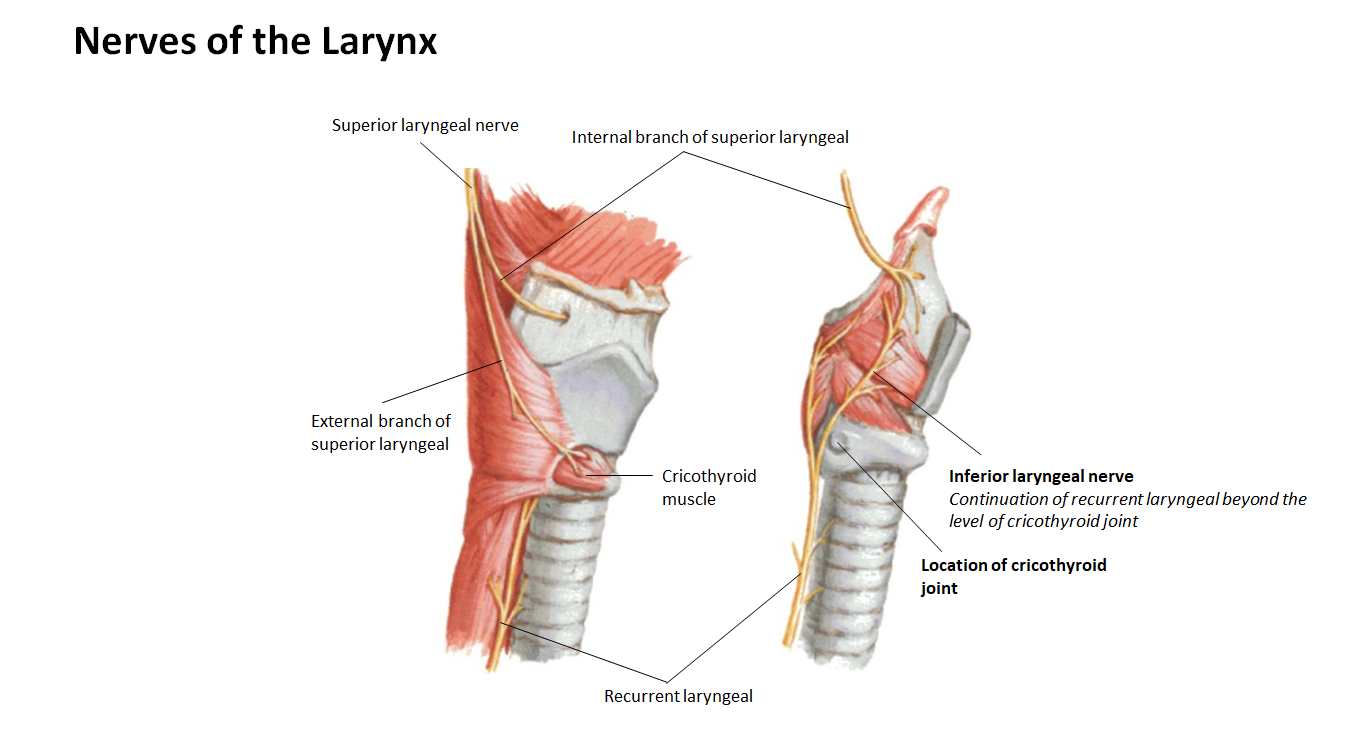
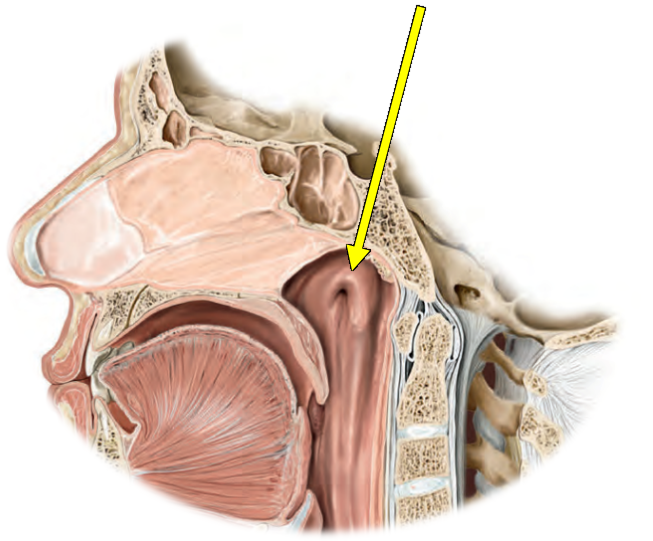
Identify the structure indicated by the tip of the arrow.
Choana
Eustachian tube
Salpingopharyngeal fold
Sphenoethmoidal recess
Torus tubarius
Torus tubarius
